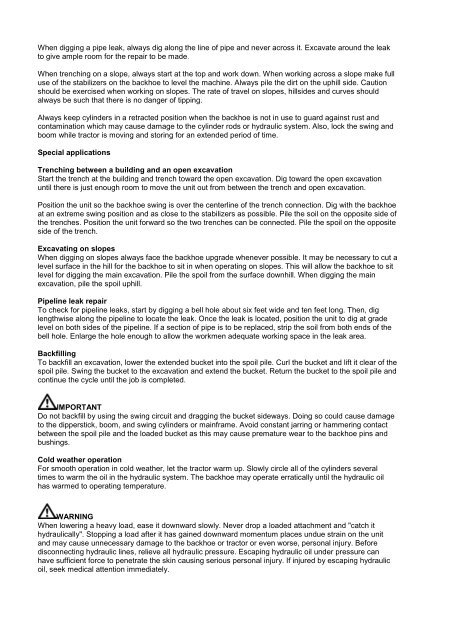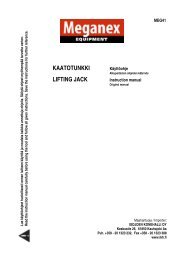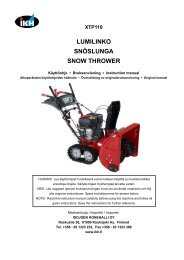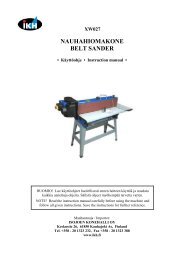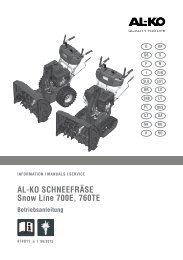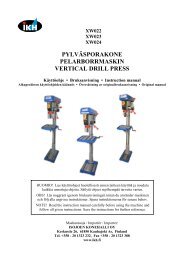INSTRUCTION MANUAL - Virtasenkauppa.fi
INSTRUCTION MANUAL - Virtasenkauppa.fi
INSTRUCTION MANUAL - Virtasenkauppa.fi
Create successful ePaper yourself
Turn your PDF publications into a flip-book with our unique Google optimized e-Paper software.
When digging a pipe leak, always dig along the line of pipe and never across it. Excavate around the leak<br />
to give ample room for the repair to be made.<br />
When trenching on a slope, always start at the top and work down. When working across a slope make full<br />
use of the stabilizers on the backhoe to level the machine. Always pile the dirt on the uphill side. Caution<br />
should be exercised when working on slopes. The rate of travel on slopes, hillsides and curves should<br />
always be such that there is no danger of tipping.<br />
Always keep cylinders in a retracted position when the backhoe is not in use to guard against rust and<br />
contamination which may cause damage to the cylinder rods or hydraulic system. Also, lock the swing and<br />
boom while tractor is moving and storing for an extended period of time.<br />
Special applications<br />
Trenching between a building and an open excavation<br />
Start the trench at the building and trench toward the open excavation. Dig toward the open excavation<br />
until there is just enough room to move the unit out from between the trench and open excavation.<br />
Position the unit so the backhoe swing is over the centerline of the trench connection. Dig with the backhoe<br />
at an extreme swing position and as close to the stabilizers as possible. Pile the soil on the opposite side of<br />
the trenches. Position the unit forward so the two trenches can be connected. Pile the spoil on the opposite<br />
side of the trench.<br />
Excavating on slopes<br />
When digging on slopes always face the backhoe upgrade whenever possible. It may be necessary to cut a<br />
level surface in the hill for the backhoe to sit in when operating on slopes. This will allow the backhoe to sit<br />
level for digging the main excavation. Pile the spoil from the surface downhill. When digging the main<br />
excavation, pile the spoil uphill.<br />
Pipeline leak repair<br />
To check for pipeline leaks, start by digging a bell hole about six feet wide and ten feet long. Then, dig<br />
lengthwise along the pipeline to locate the leak. Once the leak is located, position the unit to dig at grade<br />
level on both sides of the pipeline. If a section of pipe is to be replaced, strip the soil from both ends of the<br />
bell hole. Enlarge the hole enough to allow the workmen adequate working space in the leak area.<br />
Back<strong>fi</strong>lling<br />
To back<strong>fi</strong>ll an excavation, lower the extended bucket into the spoil pile. Curl the bucket and lift it clear of the<br />
spoil pile. Swing the bucket to the excavation and extend the bucket. Return the bucket to the spoil pile and<br />
continue the cycle until the job is completed.<br />
IMPORTANT<br />
Do not back<strong>fi</strong>ll by using the swing circuit and dragging the bucket sideways. Doing so could cause damage<br />
to the dipperstick, boom, and swing cylinders or mainframe. Avoid constant jarring or hammering contact<br />
between the spoil pile and the loaded bucket as this may cause premature wear to the backhoe pins and<br />
bushings.<br />
Cold weather operation<br />
For smooth operation in cold weather, let the tractor warm up. Slowly circle all of the cylinders several<br />
times to warm the oil in the hydraulic system. The backhoe may operate erratically until the hydraulic oil<br />
has warmed to operating temperature.<br />
WARNING<br />
When lowering a heavy load, ease it downward slowly. Never drop a loaded attachment and "catch it<br />
hydraulically". Stopping a load after it has gained downward momentum places undue strain on the unit<br />
and may cause unnecessary damage to the backhoe or tractor or even worse, personal injury. Before<br />
disconnecting hydraulic lines, relieve all hydraulic pressure. Escaping hydraulic oil under pressure can<br />
have suf<strong>fi</strong>cient force to penetrate the skin causing serious personal injury. If injured by escaping hydraulic<br />
oil, seek medical attention immediately.


